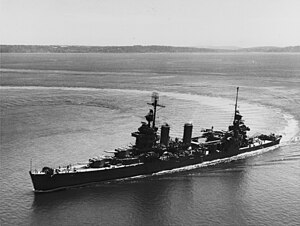
Back Тежки крайцери тип „Ню Орлиънс“ Bulgarian Třída New Orleans Czech Clase New Orleans Spanish New Orleans -luokka Finnish Classe New Orleans (1931) French Classe New Orleans (incrociatore 1933) Italian ニューオーリンズ級重巡洋艦 Japanese Krążowniki ciężkie typu New Orleans Polish Classe New Orleans Portuguese Тяжёлые крейсера типа «Нью-Орлеан» Russian
This article needs additional citations for verification. (December 2007) |
 USS New Orleans
| |
| Class overview | |
|---|---|
| Name | New Orleans class |
| Builders |
|
| Operators | |
| Preceded by | Portland class |
| Succeeded by | USS Wichita |
| Built | 14 March 1931 - 24 February 1937 |
| In commission | 15 February 1934 – 10 February 1947 |
| Planned | 7 |
| Completed | 7 |
| Lost | 3 |
| Retired | 4 |
| General characteristics | |
| Type | Heavy cruiser |
| Displacement |
|
| Length | |
| Beam | 61 ft 9 in (18.82 m) |
| Draft | 19 ft 5 in (5.92 m) |
| Propulsion |
|
| Speed | 32.7 knots (60.6 km/h; 37.6 mph) |
| Complement | 708 officers and enlisted |
| Sensors and processing systems | |
| Armament | |
| Armor |
|
The New Orleans-class cruisers were a class of seven heavy cruisers built for the United States Navy (USN) in the 1930s.
These ships participated in the heaviest surface battles of the Pacific War. Astoria, Quincy, and Vincennes were all sunk in the Battle of Savo Island, and three others were heavily damaged in subsequent battles in the Guadalcanal campaign. Only Tuscaloosa, which spent most of the war in the Atlantic, got through the war without being damaged. Collectively, ships of the class earned 64 battle stars. The four surviving ships were laid up immediately after the end of the war, and sold for scrap in 1959.
© MMXXIII Rich X Search. We shall prevail. All rights reserved. Rich X Search